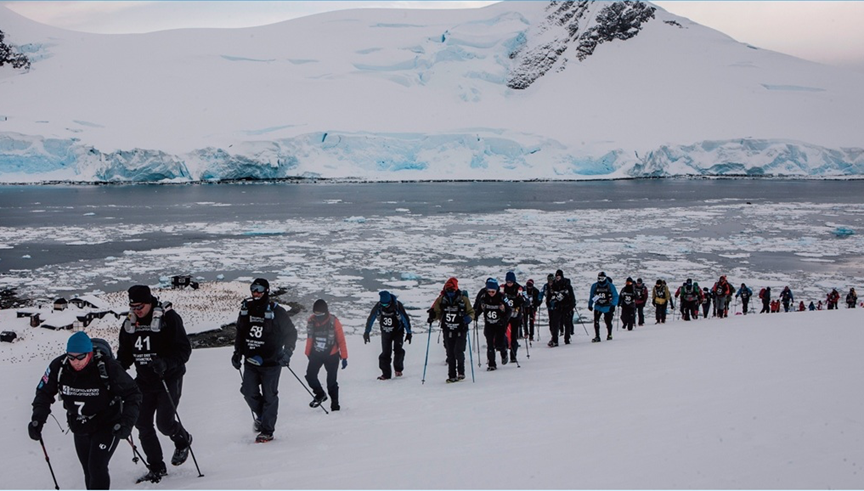Last updated: 03-Apr-19
By Tom Haynes
RunUltra Introduction: In this series of articles we follow Tom Haynes as he trains for his first ever 100-mile run at Endure 24 in June. After lots of initial research to decide on a training plan, it’s time to get an update on how he’s doing, including mental preparation and his nutrition plan. Here’s Part Two.
Dan Stinton, Interim Editor.
Part 2
It is now 9 weeks since I started my training plan and overall, I am very happy with the effort to get out almost every day and pound the pavement. January and the first part of February were fairly trouble free. I have thought twice about stepping out of the door on some occasions, but not more than an ‘urgh, the couch is much more appealing…’.
Below is a snapshot of my training plan to date. The numbers are simply distances ran in km, with a total at the end of each week (my weeks start on Monday). You will notice that I do my long runs on Sunday, with the back-to-back runs on a Monday as I tend to run straight home from work on a Monday evening.
Dashes are planned days off (holidays), whereas 0’s are rest/conditioning days.
I like this schedule because it means I can get in a half normal weekend, using Saturday as a rest day. It also means that I have more experience running tired, frustrated and at night time. Although the plan is the same, the routine always depends on how well my day at work goes, which is great mental training.
Running from work has been great fun. I generally just start running through the streets and estimate my remaining distance. Sometimes I fall short by a kilometre, but sometimes I end up doing a bit extra. Every run is more exciting when I don’t run the same route over and over.
So far, I have kept to my planned total weekly mileage (within a couple of kilometres) and no significant deviation from individual run lengths. The long runs are steadily increasing without any problems. My biggest challenge will be trying to maintain the schedule in amongst weekends away and visits from family and friends.
Every weekend includes a long run of some sort so I will have to juggle my time. Currently there are four weekends with family from Australia, and two weeks away in April and May. The timing could not be worse, but I think I have tweaked the schedule just enough to make my training work around these commitments. Only time will tell…
Mental Performance
Running can be very lonely. I still get days where I don’t start the run in the right mood. Sometimes it’s the small things adding up, sometimes it’s something else out of the blue. Either way, getting out and running every day seems to make even the short runs start to feel lonely.
I like to change it up, listening to music one day and then playing songs in my head the next to help keep my mind active. For those of you that enjoy trance music, I have found Ferry Corsten’s album Blueprint to be a great running companion. It has been constructed as a narrative about a boy who unlocks AI from a musical rhythm.
In the end, it’s the little things that get me through each run, like finding this BBC TV set:
I stumbled across this film set for BBC TV series ‘World on Fire’, while running through Ainsdale forest.
or this little winter oasis:
Shortly after running past the film set, I found a pocket of the forest which was open to the dry air, but closed to the warmth of the sun. Finally, some snow on the ground!
Maintenance
Hopefully, if you’re reading this, you have basic knowledge of exercise and recovery. I have read a lot about it, but this is the first time that I really appreciate it. Historically, I am one of the least disciplined stretchers and therefore least flexible active people that I know.
After every run, I have forced myself to stretch out so that I’m ready to go again tomorrow. In particular, I concentrate on groin, hips and most of the legs. So far, I have been able to wake up and move everyday with no pain or stiffness. DOMS (delayed onset muscle soreness), otherwise known as “second day hurt” to some, seems to have disappeared for me.
This isn’t just about the recovery though, I’m keeping my heart rate low to train my body to burn energy differently and also means I am not straining my muscles to the point of breaking on every run. Forcing myself to go slow is most noticeable when I’m trying to run every day.
Nutrition
Although I’m happy with my diet in general, I had to make changes to suit my increased workload and change in overall goal. There is plenty of advice on ultra running nutrition available but I decided to follow a plan that takes on protein, fats and lowers carb intake whilst continuing running. I’m lowing carbs with the intention of training my body to run on fat burning but not cutting out carbs completely.
Taking on less carbs has been the hardest for me. This mean less energy, which sometimes translates to a moodier Tom. It also differs significantly from my marathon runs and 24-hour strategy from last year. After each lap I reloaded with carbs in preparation for the next effort.
In saying all that, there’s always a place in life for comfort food. In particular, I have a soft spot for a good apple pie! I have had a few of them in the last two months. There was also a run that I started with very little motivation and it quickly dwindled to zero. I altered my course so I could finish with a chicken burger. I just wouldn’t do it every day or it’ll negate all of my hard work!
Running Gear
February meant a new running pack and a new me! I must admit that I probably should not have been as surprised as I was, because my existing running pack was a £15 job from Trespass. It was great as a beginner pack, but even upgrading to a £30 pack has made a huge difference. I purchased a 10 L Kalenji pack which feels really comfortable and does not move an inch, full or empty.
February also meant the stint of cold weather. We finally had consistent frost and pockets of snow for a couple of weeks. Unfortunately, nothing as majestic as I’ve seen from North America, but still enough to make me wrap up a little tighter.
Generally, I have run in a pair of long leg tights, thermal top and light Puma jumper. My legs are usually OK in the cold, but the tights help against grass and shrubs while running on trails. My most important pieces of my kit are my £2 acrylic gloves, an ear covering beanie and buff. My fingers freeze in about the same amount of time it takes to sneeze so those gloves have saved me hours of grievance.
While not anything special for performance, I am a big Marvel nerd and love Captain America. I found a very nifty eBay store selling printed compression tops a couple of years ago and have only just needed to replace the original couple that I bought. Very cheap, quick drying, excellent print quality and they do not seem to attract the smell that some cheap shirts do.
Weather
Last, but not least, my training journey so far has been based on luck and possibly good judgement. During the early stages of training I had yet to set off for a run with any significant rain. Unfortunately, after nine weeks of running, I finally ran out of luck. My weekly long run was nearly three hours almost solely in the rain. Thankfully it was never more than a light shower, but that was my stretch of dry runs over.
Take a look at Tom’s blog here.
Liked what you read?
Here’s Part 1 and Part 3 of the series of articles from Tom if you missed them.
Do leave a comment below if the article has helped you prepare for your first 100 miler.






